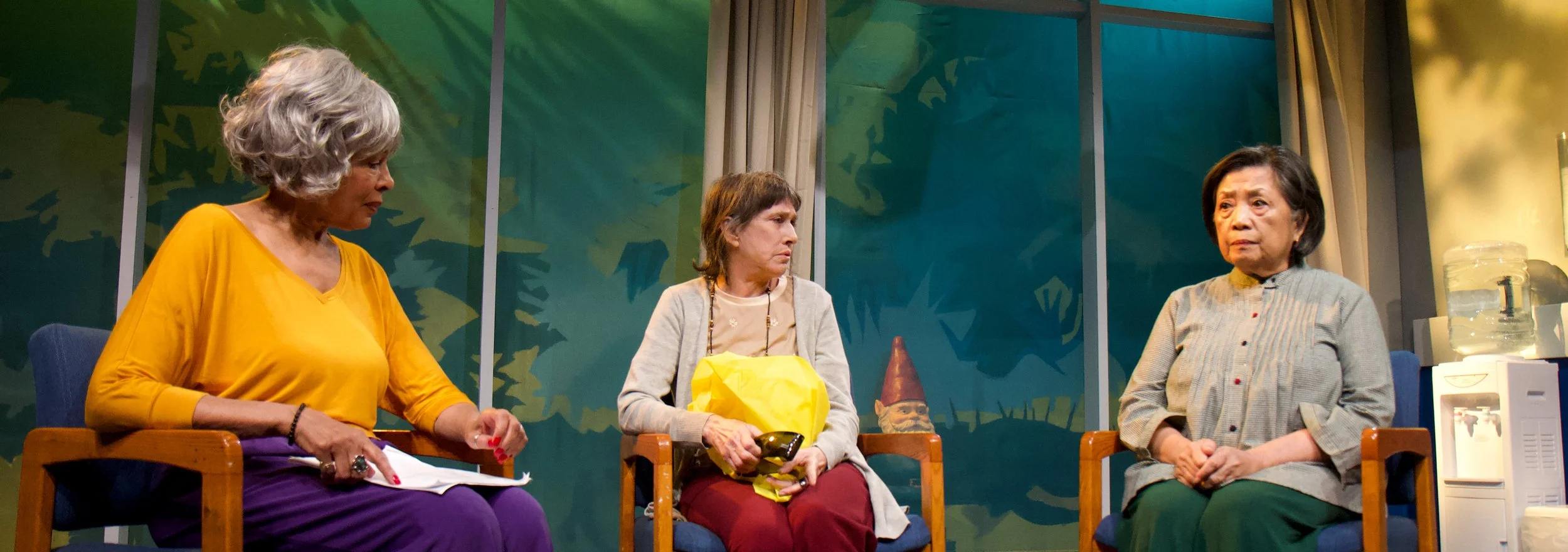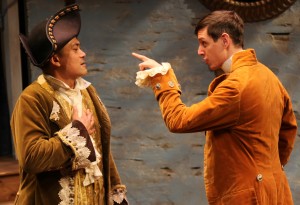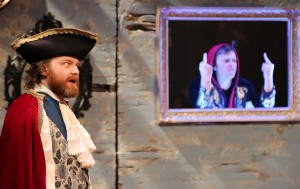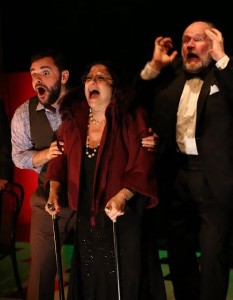What’s odd about Body: Anatomies of Being at the New Ohio Theatre, is that, as much as it wants to break the audience out of being shocked by nudity, the script doesn’t measure up. The dialogue goads the audience to be comfortable with the body and all of its functions, “Wake up. Fart. Pee. Blow nose while pooping. Burp. Yawn. Drink water. Burp. Cough. Blow nose. Pick at clogged hair follicle under right arm. Burp.” But seriously, to what end? When all the actors have plucked and trimmed their pubic hair to a landing strip, are you really that comfortable with the body? A number of challenges steer this production off purpose.
A Game of Treachery
Letter of Marque Theater Company’s Double Falsehood is a tight and neat production of a play credited to William Shakespeare and John Fletcher, and adapted for the 18th-century stage by editor Lewis Theobold. There is some debate whether Shakespeare actually wrote this play, but director Andrew Bothwick-Leslie, in program notes, suggests that audiences put that aside and enjoy the ride through this “wild and unnerving story.”
Double Falsehood is a story of betrayal, forced marriage, rape and reconciliation. Duke Angelo, played by Nolan Kennedy, has two sons. Roderick (Welland H. Scripps) is upstanding, while the other, Henriquez (Adam Huff) is a hooligan. Henriquez causes a lot of trouble for everyone because he can’t keep his desires for women who don’t want him to himself. First, he rapes Violante, played by the wonderfully physical Poppy Liu. At one point, when she is overcome with disgust after Henriquez’s violation, she rubs and hits her body as if she could physically rid herself of the experience.
Next, Henriquez insists on marrying Leonora (Montana Lampert Hoover), his friend Julio’s (played by Zach Libresco) love interest. He does it because he can. After all, he is a nobleman, which trumps Julio’s power. Not only that, Leonora’s father, Don Bernardo, played with weight and depth by Ariel Estrada, is so hungry to align himself with the Duke’s wealth that he forces the marriage to take place even though Leonora refuses. Like King Lear, Don Bernardo is full of hubris and self-import. And also like Lear he is humbled in the end, but not before he bellows in rage at his daughter to make sure she marries Henriquez.
As the enfant terrible, Huff does an excellent job and resembles a young Johnny Rotten with his shaggy light-blond hair, which he spikes at times or slicks down at others. His nimble, earthy walk and demeanor give him the charm of a snake making its way slowly toward its prey. Unfortunately, all in his path are hurt by his actions, and he shows no compassion or remorse. He feels perfectly entitled to get what he wants.
The costumes, by Claire Townsend, are an intriguing mix of metaphors, and emphasize the quality of the characters well. Some wore more traditional-looking Elizabethan garb while others, such as Julio and Henriquez, wore contemporary clothing. Henriquez’s costume, in particular—red sneakers, a red hoodie, and a long black coat with gold embroidery on the front—made him look like a hipster straight out of Williamsburg and heightened his “I don’t care what anyone thinks” mentality.
One of the best scenes that Bothwick-Leslie stages is a simulated horseback ride through the woods by Scarlet Maressa Rivera, who plays a citizen, and Gerald, a messenger of sorts. Rivera “rides” through the woods as other cast members run past her with tree branches and a drum beats to indicate horse’s hooves. It’s a wonderful and original idea that is twice as enjoyable the second time. Nolan Kennedy, who plays the Duke, is also the music director, and the lovely musical scenes including a trio singing about death and love, accompanied by Kennedy on the ukulele.
The company did a good job of using the Irondale Center playing area in a beautiful old church. The space has been rendered wide open (no pews or built-in stage, etc.). It can’t be transformed into a black box, but the company utilized rolling panels and a small platform, conceived and designed by Steven Brenman, to create a smaller performance space. At times, the panels were removed to show a wider space, or more distance between places. In Elizabeth theater, time and space were indicated through language, but these small visual indicators helped orient the viewer, especially at the end when there was little movement and a lot of dialogue.
Luckily, all’s well that ends well, in the manner of Nicholas Sparks’s romantic novel The Notebook. When Leonora and Julio are finally reunited at the end of the play, they run to each other and Julio scoops her up high into his arms. Cue the rain. It’s a soppy and romantic moment, but effective nonetheless. If it started out worse than real life, it ends better and, although Henriquez’s actions are particularly heinous, our faith in redemption and justice are restored.
Letter of Marque Theater Company’s production of Double Falsehood plays through April 9. Performances are at 7:30 p.m. Tuesday through Saturday at the Irondale Center (85 S. Oxford St, Brooklyn). Subway directions: C train to Lafayette Avenue; B, D, M, N, Q, R, 2, 3, 4, 5 trains to Atlantic Avenue/Pacific Street; G train to Fulton Street. Tickets are $20; a limited number of tickets will be given away free to the public. To learn more, visit www.lomtheater.org.
Quatorze, Rouge, Manqué, Pair!
The Gambler opens much like a Sunday afternoon in the Arbat District of Moscow in the 1800s—the cast strolling across the stage familiarizing us to the characters. Charming, enigmatic, prideful, stuffy and arrogant are just a few attributes that come to mind when observing each character. Glyn Maxwell’s play, based on the 1866 Fyodor Dostoevsky novella of the same name, is currently running at The Wild Project in New York City through Feb. 14. Dostoevsky, in a time of financial difficulties brought on by an out-of-control gambling habit, dashed off the novella to pay down debts basing the work on his current state of affairs. The set is perfectly stark with a bench and four chairs, which are aptly utilized throughout the one hour and 45 minute performance. Lighting, by Tsubasa Kamei, creates scenes perfectly suited to the sparse set, although some shadows need to be addressed. The playwright crafted an ensemble piece in The Gambler, and with the direction of Karen Lordi-Kirkham, we are invited to experience a vivid ensemble, led by the affable Alexi, played by John Cosentino. What Cosentino is truly capable of becomes evident during an interchange with Matt Stapleton, who brings all the best qualities of a Brit as Astley. Rounding out the suitors is Joseph J. Menino, portraying the ruthless French investor, de Grieux, who delivers an equal amount of bravado and rich mannerisms to his character.
These three suitors, each in their own style, desire the attention and hand of Polina, (Poppy Liu) the General’s niece and ward. Polina is conniving in a schoolgirl way, and yet, “is no one’s ward,” further declaring, “I am no one’s anything.” Given as much rousing attitude as comes through in Liu’s words and expressive eyes, a more upright attitude in her posture would have been an added bonus. Whereas next to Alexi, whose posture takes on downtrodden, subservient qualities, Polina requires the stature her upbringing would have taught her thus far in life.
John Lenartz effusively rounds out the performance as retired General Zagorski, with the vibrant Elise Stone bursting on the stage as Antonida Tsareyevitch Vassilyevna, referred to as "Granny." Add the convincing, conniving and climbing Morgan Rosse as Blanche de Cominges and the ensemble is accomplished, deep and tight. The director provides them with ample opportunities to bring their best; the carriage ride, the soup scene, and of course, the roulette table! It’s hard to take your eyes off Granny, Alexi and the General at the table as all the characters have a stake in the outcome. They each bring the scene into existence in their own delightful style.
The details are where the script becomes uneven, lacking deference to Russia and St. Petersburg in the 1860s, which is most evident with Granny’s pronouncement, “You’re not getting a f*#@*ing ruble!” And then her use of the word, "Frenchie," at the roulette table, or when she refers to her mode of travel as a "choo-choo train." For a wealthy Russian aristocrat who is richly colorful, her dialogue comes off childlike or common at times. Even referring to her character as "Granny" rings odd. Polina is spoken of as “a Russian spiritual young soup-stirring lady.” While her character may be spirited, she exhibits little in the way of spirituality.
Ellen Mandel deftly handles the sound design along with original music for the opening and closing. The gentle clacking of the carriage ride, the crystal and china effects at the dinner table, and the spinning wheel of the roulette table added to the experience and never overplayed the actors. Homage to Dostoevsky and the rich music of Russia, though, would have only added to the experience.
Costume designer Jennifer Stimple-Kamei delivers clothing and jewelry befitting of the characters and is well done for the most part. Alexi is attired in brown tones and a vest very much in keeping with his position, while the General, Blanche, de Grieux, Astley and Granny wear their wealth and class smartly. Polina’s costume and hair, however, occurs as an afterthought sporting a very lightweight long blue skirt and cream-colored camisole. The youthful Liu embodies a present-day feel rather than a Russian heiress in the 1860s. More options, in keeping with the period, seem readily available with Liu’s beautiful long hair than a simple ponytail.
While you might think Dostoevsky was writing about his own predilection with a title like The Gambler, you’ll find that with the exception of the Grandmother in this production, everyone delivers his or her own version of a gambling problem. No one better, though, than Alexi holding a coin high at the roulette table eagerly placing one more bet.
The world premiere of The Gambler is presented by Phoenix Theatre Ensemble, and runs through Feb.14 with a mix of evening and matinee performances at The Wild Project (195 E 3rd St. between Avenue A and B) in Manhattan. Tickets are $25 and can be purchased by calling 212-352-3101 or visiting phoenixtheatreensemble.org/the-gambler.










